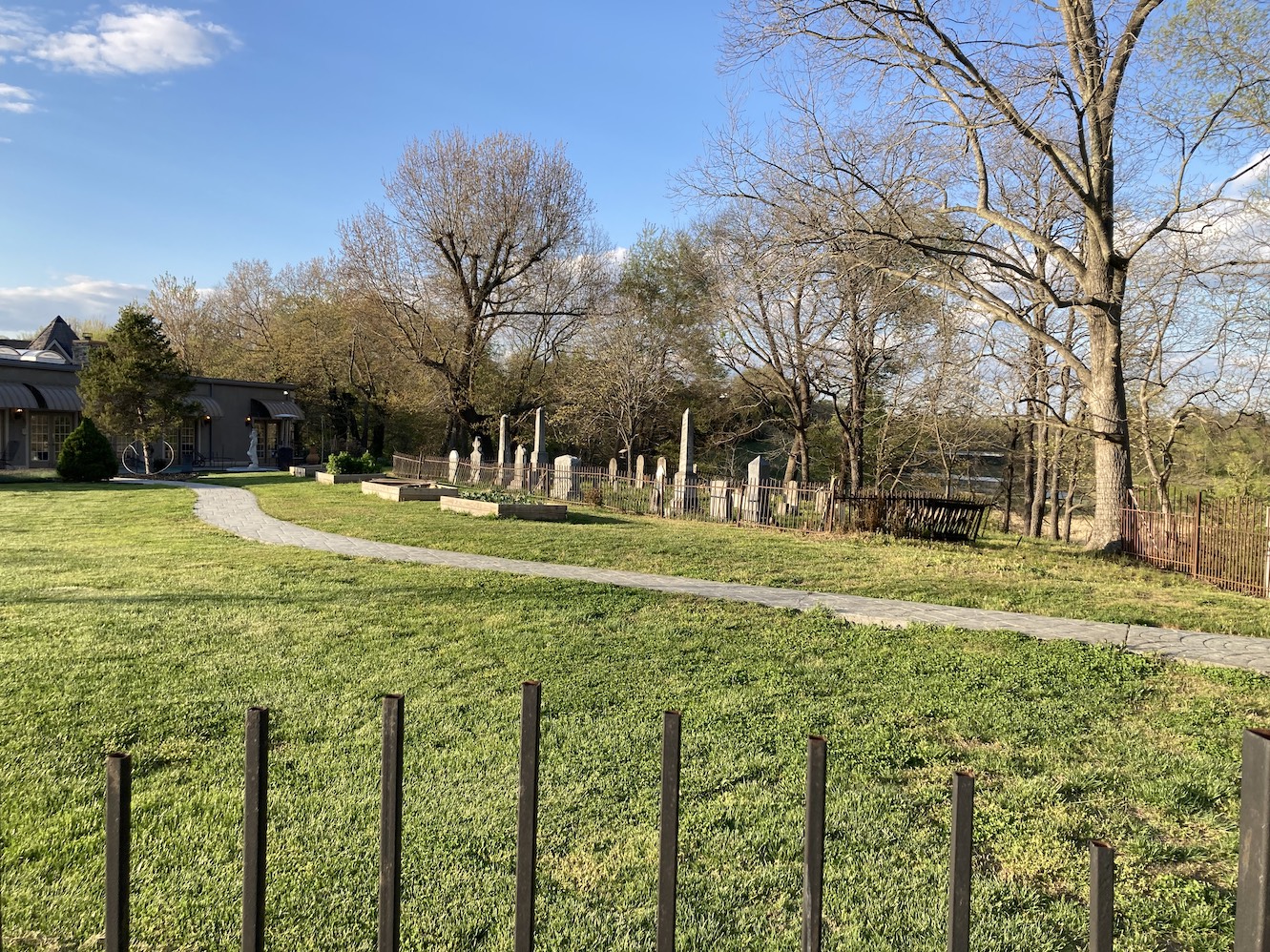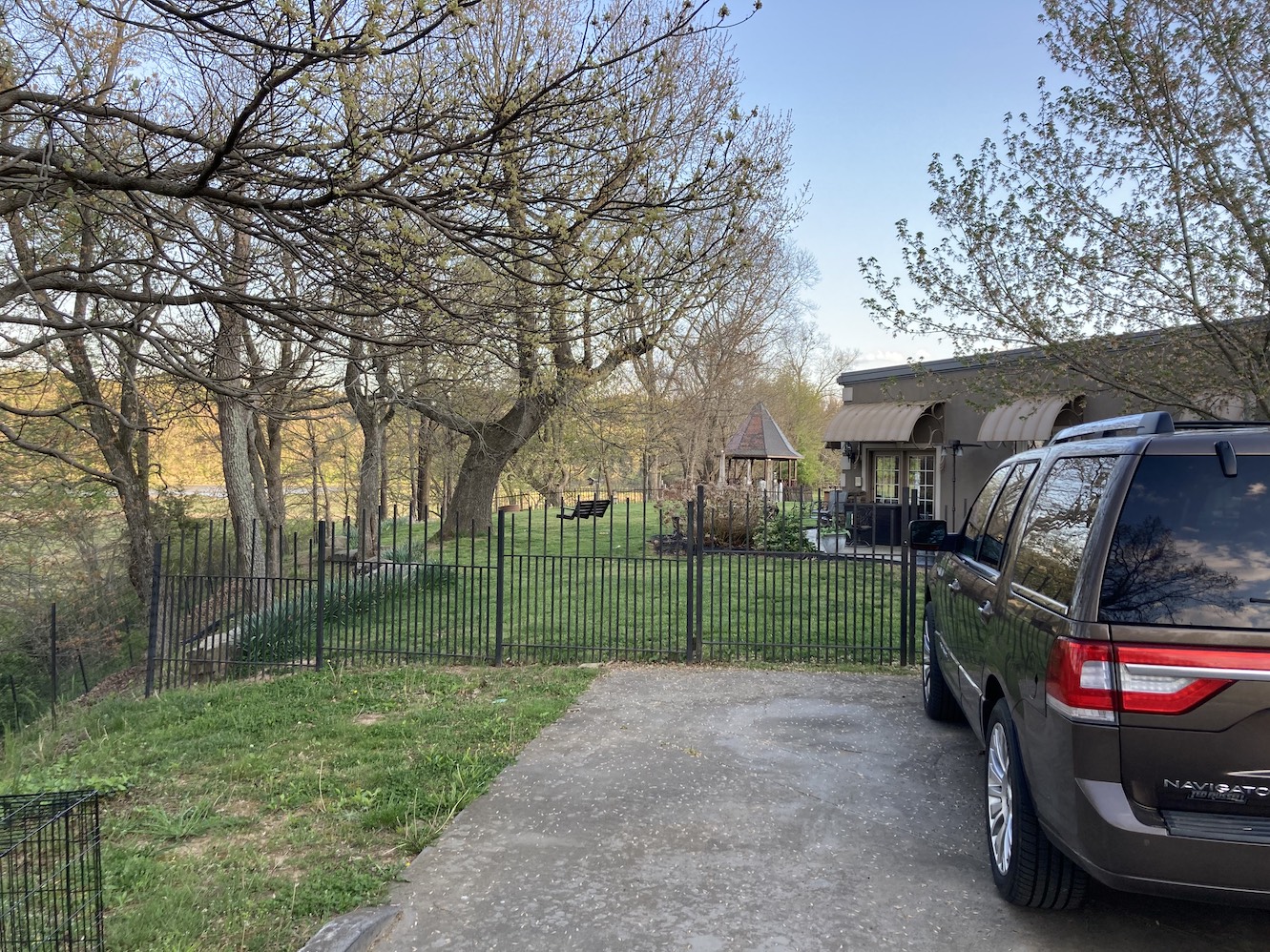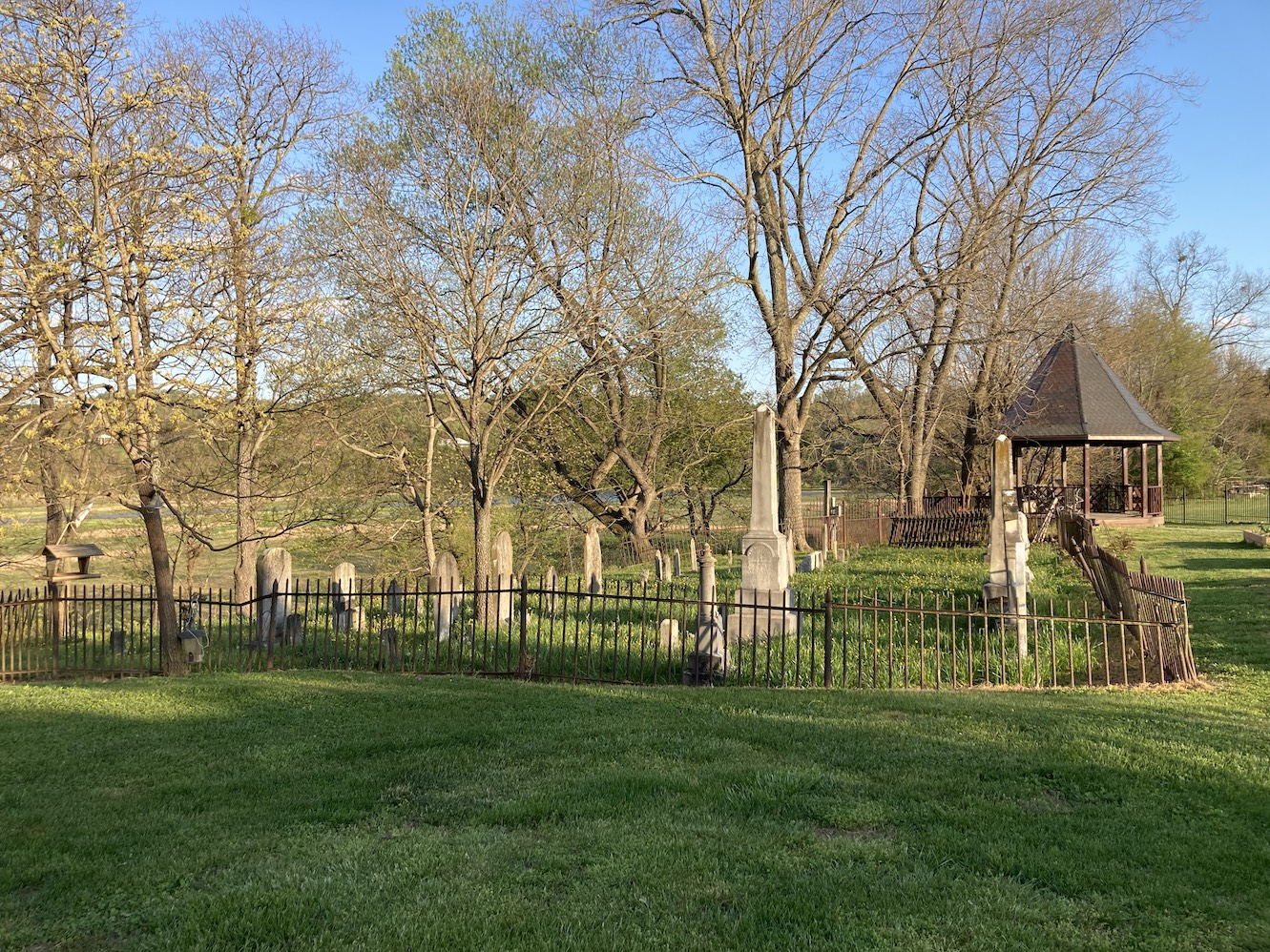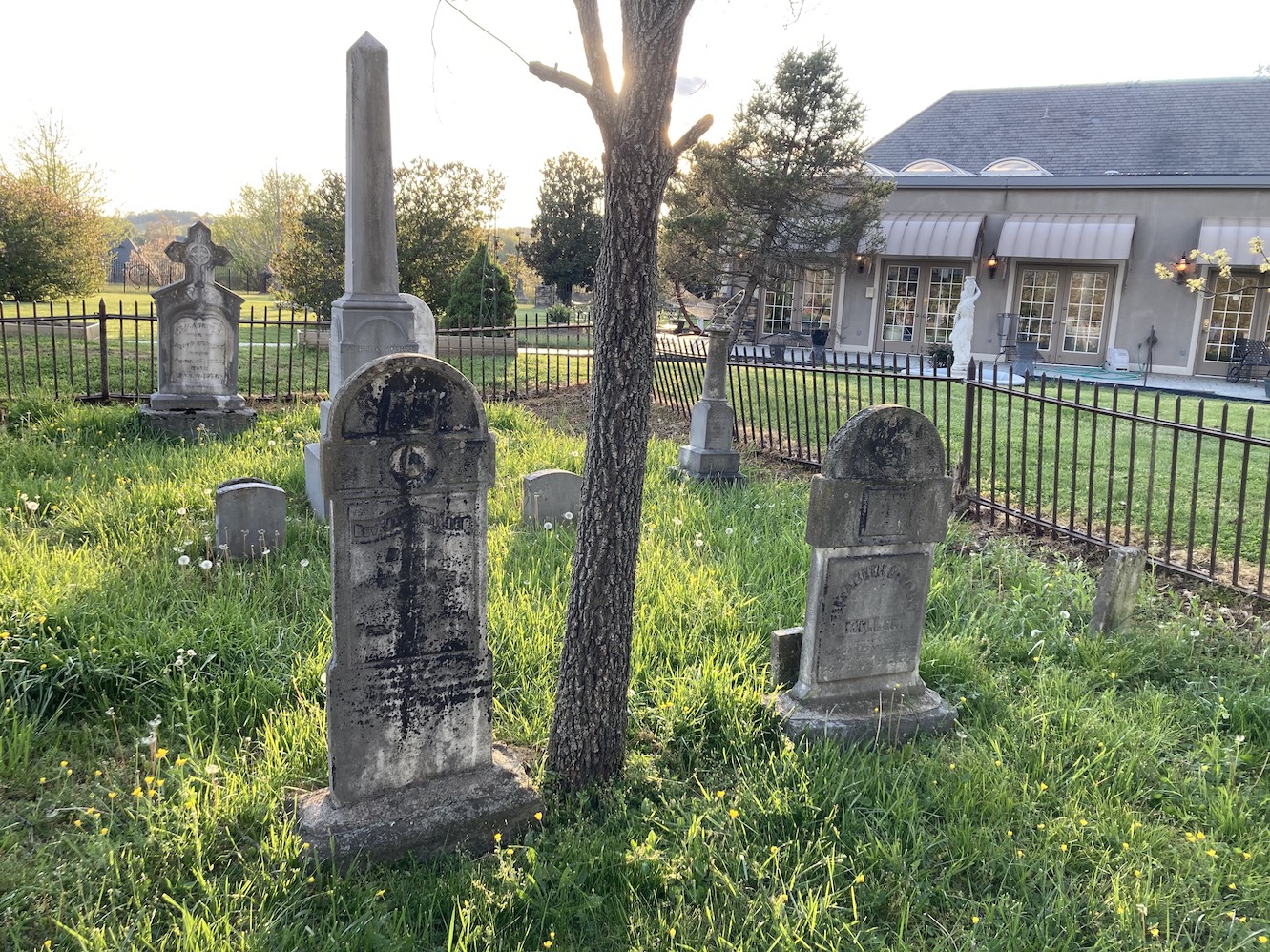James Miller
1798-1874
[photo needed]
![]()
Brief Family Sketch
James Miller was born March 23, 1798 in the state of Maine. He was the son of Peter (Mueller Meller) Miller (1753-1819) and his mother’s name was Elizabeth Mary Bohn. (1755-1819). He was married to Elizabeth P. DeVault (1804-1877) on March 24, 1827 in Washington County, Tennessee. They had four children, James Valentine Miller (1828-1843); Osburn S. Miller (1830-1845); James Miller (1832-1833); and Oliver P. W. Miller (1845-1860).
The following short summaries of his life show James Miller as being a capable preacher of the gospel of Jesus Christ. Converted by the preaching of Barton W. Stone, this man preached in Kentucky, Ohio, and Tennessee. Settling in the early days of the Restoration Movement in Eastern Tennessee, he planted the church near Johnson City at Boones' Creek. Many were baptized into Christ under his preaching. Also, many of these followed in his footsteps preaching the gospel in the region.
-Scott Harp, 12.27.2022
Source: Ancestry.com
![]()
James Miller: His Life
by Mary Hardin
Born in the state of Maine, James Miller was ordained to the gospel ministry in Kentucky by Barton W. Stone. He came into Tennessee in the early part of the nineteenth century and bought land on Boone's Creek, and there married a native daughter, Elizabeth Devault. (The obituary of James Miller by S. H. Millard states he was ordained by Barton W. Stone. There was some discussion by the Baptists of Tennessee about his baptism being acceptable to them.)
He was at first identified with the Sinking Creek Baptist Church from which church he applied for a letter of dismissal on Saturday, April 16, 1825. This was granted. As we find a Carter County marriage license returned by him in 1826 and signed as Minister of the Gospel we may conclude that this must place an approximate date on the great revival conducted by him on Boone's Creek. There were a great many converts during this meeting, many coming from the old Buffalo Ridge and Sinking Creek Baptist churches, both being near by. The Brick Church on Boone's Creek was the outcome of that meeting and thereby is the mother of our upper East Tennessee Christian churches, being antedated in Tennessee only by the Post Oak Springs church in Roan County, which dates from 1812.
James Miller also helped to organize Buffalo Creek Christian Church, together with James Ireland Tipton. The earliest extant record of Buffalo Creek (now Milligan College) is an old Treasurer's book kept by Michael Hyder, Jr., dating 1835. But Buffalo is mentioned in 1834 in the Boone's Creek records, and in 1832 in the obituary of John Wright, who was ordained to preach then by Elders James Miller and David Duncan at Buffalo Creek Church.
James Miller and his wife moved to Johnson City after the Civil War, owning property in the center of what is now Main Street, and near a lovely spring. When the First Christian Church was organized in 1871, Brother Miller and wife were among the first members. Before his death on February 19, 1874, he had donated land to be used after his death as the site for a church. This little church was erected with John Wright (who died in 1875 before its completion), Jordan C. Hardin, Henry H. Crouch, and Wm. C. Maupin as the Building Committee. Edmund C. Bayless was the contractor. The church was finished and dedicated in the late fall of 1879 by Dexter Snow of Virginia, Brother Wm. C. Maupin being the first pastor.
Col. E. C. Reeves, a nephew of Mrs. Miller, describes James Miller thus— "The Rev. James Miller was a ripe scholar, a fluent speaker, and withal a real logician."
He conducted a remarkable religious revival on Boone's Creek in this county, which for its scope and sweep, was a wonder in that day and time, for in the community nearly every soul was gathered into the Christian church, and through the generations following the present, the Christian church dominates all others in that community. The Brick Church was the outgrowth of that meeting—and from it have gone out men and influences which have proved the primal human causes of the development of the Christian church into the commanding position it occupies today.
James Miller was no ordinary man. He dug deep and laid foundations solid and lasting. In those days of strenuousness between the various Protestant churches when public debates were in vogue, he proved himself a debater without a superior, indeed a peer, in this region. He was old in his advocacy of religious principles, and an intrepid defender of the same, yet his spirit was as sweet as summer. Verily he was great in goodness, and good in greatness. His church which he so much fashioned and forged into prominence in this section of the country, is under lasting obligation to ever revere his memory. His sleeping dust is entombed in the Devault Cemetery on the banks of the Watauga river, marked by a stone of meager cost. "His works do follow him."
-By Mary Hardin, (Mrs. L. W. McCown), J. W. West, Sketches of Our Mountain Pioneers, pgs.47-49
![]()
James Miller And Boone's Creek Church
One of the earliest preachers in upper East Tennessee was brother James Miller who was born in Maine in 1798. He migrated to Tennessee by way of Ohio and Kentucky. There it seems he came in contact with Barton Stone. On October 16, 1824 he was received into the Sinking Creek Baptist Church in Carter County, Tennessee after relating an acceptable religious experience. Six months later on April 16, 1825 he asked for and received a letter of dismissal from that church.1 (1. Harry C. Wagner, History of Disciples of Christ in Upper East Tennessee (Master's Thesis, University of Tennessee, 1943), pp. 45-46.) It does not appear that brother Miller ever preached for the Baptists. By 1826 Miller was performing marriage ceremonies as a "minister of the Gospel." A later record states that he was ordained by Barton W. Stone and "commenced to preach in upper East Tennessee, . . . and contending that party names tended only to divide the people of God." 2 (2 Samuel H. Millard and T. J. Wright, Biographical Sketch of John Wright, as quoted in Harry C. Wagner, History of Disciples of Christ in Upper East Tennessee (Master's Thesis, University of Tennessee, 1943), pp. 45-56.) Soon after separating from the Baptists, brother Miller conducted a great revival meeting in Boone's Creek Valley, Washington County which resulted in many additions. This would have been the summer of 1825. Miller's preaching divided the Buffalo Ridge Baptist Church. An investigative committee from the Holston Baptist Association found Buffalo Ridge a "divided people in principle and practice."3 (3 Minutes of the Holston Baptist Association, as quoted in Harry C. Wagner, History of Disciples of Christ in Upper East Tennessee (Master's Thesis, University of Tennessee, 1943), p. 49.) In the records of the Sinking Creek Baptist Church, October 18, 1826 is the following note:
We also declare against Molly Humphries for joining Miller's church . . . . We unanimously agree not to invite any of the people calld (sic) Arians Socianian Unitarians or Sysmatics or that will not Wright (sic) their creed to preach in our meeting house.4 (4 Sinking Creek Baptist Church Records, p. 94, as quoted in Harry C. Wagner, History of Disciples of Christ in Upper East Tennessee (Master's Thesis, University of Tennessee, 1943), p. 49.)
It was common for their denominational neighbors to associate Stone and his followers with these heretical groups. This was because the Christians would not subscribe to their credal statements about the trinity. Also it was a "name-calling" tactic to besmirch their Christian faith and prejudice folks against them.
Baptist historian, J. J. Barnett records that Buffalo Ridge Baptist Church was reduced from 350 members to fourteen by the "Arian heresy as taught by Barton Stone and Alexander Campbell . . ."5 (5 J. J. Burnett, Sketches of Tennessee's Pioneer Baptist Preachers, p. 537, as quoted in Harry C. Wagner, History of Disciples of Christ in Upper East Tennessee (Master's Thesis, University of Tennessee, 1943), p. 50.)
In his new home, Miller found a wife, Elizabeth Devault. Brother Miller supported his family by farming and teaching. His preaching was done at nights, on weekends, and when the crops were laid by. He taught at the Boone's Creek Seminary.
Colonel E. E. Reeves wrote the following glowing description of brother Miller:
Once there lived a man in this country whom I knew three-quarters of a century ago . . . . He hailed from Maine . . . . He was a minister of the gospel in the Christian Church. of heroic size, with a benevolent face and a dignity in his bearing, he was a commanding figure in any assemblage of people. The Rev. James Miller was a ripe scholar, a fluent speaker and withal a real logician. At first he was a school teacher during the week and a pulpiteer on the Lord's day. However, soon he devoted his entire time to his holy calling, leaving the management of his extensive farm to his practical wife. Ere long he conducted a remarkable religious revival on Boone's Creek in this county, which in its scope and sweep, was a wonder in that day, for in that community nearly every soul was gathered into the Christian Church; and through the generations following to the present the Christian Church dominates all other churches in that community. The Boone's Creek Brick Church was the outgrowth of that eventful religious awakening, and was longer and more widely known, than probably any other in a large section of our country. From it have gone out men and influences which have proved the primal human cause of the development of the Christian Church into the commanding position it occupies in our section of the country.6 (6 Ibid., p. 46.)
Most of those won from the Baptists became members of Boone's Creek Christian Church.
When they formerly organized their congregation, the Boone's Creek brethren drafted and signed the following statement:
We the members of the Church of Christ at Boone's Creek have met together on the twentieth day of September in the year of our Lord One Thousand eight hundred and thirty-four and according to the Acts of the Apostles The church have chosen from among us seven men of honest report and ordained them elders of the church. And Daniel Fox a member of the church was appointed clerk of the church on the same day and year above mentioned.
ELDERS
James Miller
Jacob Miller
Jacob Range
Daniel Snider
John Elsy
Jeremiah Bacon
Jesse Hunt
George Grisham
DEACONS
William White
Daniel Isenburger
John V. Hoss7
(7 Beaver Creek Church of Christ church records, as quoted in Harry C. Wagner, History of Disciples of Christ in Upper East Tennessee (Master's Thesis, University of Tennessee, 1943), p. 51.)
The membership list showed forty-four brothers including several negroes, each identified as "man of coler (sic)." The names of ninety sisters are given. It is thought that Boone's Creek Church first began meeting as early as 1829 though it was not fully organized with elders and deacons until 1854.
In September of 1841 John Wright, James Miller, James I. Tipton, and David T. Wright participated in a great gospel meeting at Boone's Creek which won fifty-six souls for Christ. The rapid growth of the church is seen in her membership figures.8 (8 Alexander Campbell, editor, Millennial Harbinger, New Series, VOl. 5, December 1841, p. 590.) In September 1841 she had 156; in February of 1842, 238; in July 1842, 259; in August 1843, 299. When the Civil War began there were 318 members. After the disruptions of the war only seventy-three members were accounted for.9 (9 Wagner, History East Tennessee, p. 53. 50) This sad experience was repeated throughout the South.
Numerous preachers were sent forth by the Boone's Creek Church. Among them were Spotswood Dodge (1850), Hezekiah Hinkel (1866) a black brother, (Note: Dr. Hezekiah Hankel was James Tipton's next door neighbor in Johnson City according to the 1870 U.S. Census, sdh) W. C. Maupin (1867) and John Ellis. Brother James Miller died February 19, 1874. In his will he left a lot in Johnson City to the church for a building site. A comfortable meeting house was erected by the brethren.
John Waddey, Churches of Christ in East Tennessee, pages 45-50
![]()
Report to Barton W. Stone's Christian Messenger
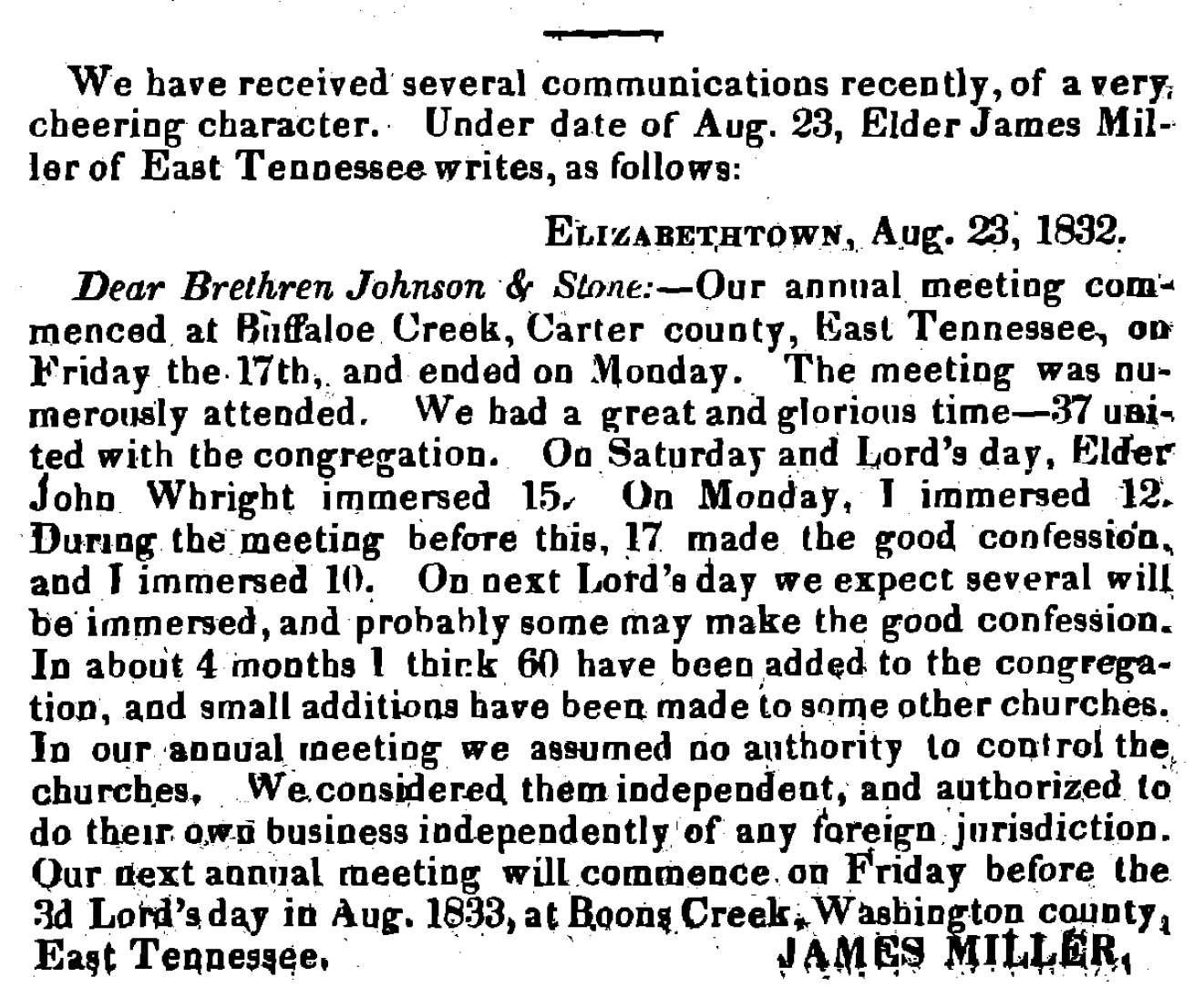
Christian Messenger, Vol. 6, p.298
![]()
Excerpt Form "Like Fire In Dry Stubble"
J. W. Roberts and R. L. Roberts, Jr., Restoration Quarterly, "Like Fire In Dry Stubble" Part 1, Vol. 7 #3, Third Quarter, 1963, p.156
(Click on article to zoom in)
![]()

E. W. Humphreys, Memoirs Of Deceased Ministers, c.1880, page 242
![]()
Rev. James Miller's Sermon
The Jonesborough Whig, Jonesborough, Tennessee
Wednesday, April 20, 1842, page 2
(Click on article to read)
Transcription As Follows:
Rev. James Miller’s Sermon:
On Sabbath last, we attended on Boon’s Creek, to hear the Rev. James Miller, of the Christian Church, deliver a discourse against the practice of the Baptists, in re-immersing persons, who have been immersed by other denominations;—and we do not recollect to have been more highly delighted on any similar occasion, than we were on this. The congregation was the largest we have seen convened on an occasion of the kind, in twelve months—consisting of persons of all denomination, and paying the most marked attention. The speaker detained the audience just three hours and 35 minutes. Mr. Miller is a man whose irreproachable life places him above assault, and whose abilities will command the attention of the people. In giving an outline of this discourse, we cannot do any thing like justice to the speaker, and so advertise our readers.
EXORDIUM
He expressed his gratification at seeing so great a multitude; said he made the appointment two months ago, & promised to deliver a discourse on the subject of RE-IMMERSION; said it was a subject of vital importance, and one in which all present were more or less concerned.—He had no desire to wound the feelings of any—was acting on the defensive—said that the controversy had been forced upon him—he had been unchurched by his Baptist brethren, as had all other denomination—if he did not defend himself and his principles, he ought to be regarded as unworthy of notice—that he had frequently been basted at a distance but that if he could meet his opponents face to face, then would come the tug of war—he said he should speak candidly, and for hours—he had a right to do so—he claimed an impartial hearing—and was pleased to see so many Baptist friends present.
THE TEXT.
“But do not think me your enemy because I tell you the truth.”
DIVISIONS.—First, Dissimilarity between the Baptism of John, and that of the Apostles. Under this head, six positions, declaring John’s and the Christian Baptism to be different institutions, were fully sustained by Scripture and reason.
II. Objections to re-immersion.
1. The practice is without command, example, or inferential proof.
2. The practice is in violation of Holy Writ.
3. No benefit can result from the practice of re-baptizing.
4. Baptism cannot be re-administered but for sectarian purposes.
5. Re-immersing is characteristic of a sectarian community—a community which practice too little or too much—making that too little or much essential to salvation.
6. Re-baptizing is an apostasy from the Father Son and Holy Ghost—the subject renouncing that faith into which he had been baptized, and either embracing some other, or going off into anarchy.
7. The practice of re-baptizing is a wicked profanation of the institution.
8. Re-baptizing is indicative of hypocrisy or the most consummate ignorance.
9. The administrator, in re-baptism, deludes the subject into a gross violation of the law of God.
III. The ground assumed by the Baptist in re-immersing.
1. The subject has never been baptized.
2. Baptist preachers alone have the right to baptize.
3. The Baptist Church is the only church of Christ on earth.
4. The Baptist ministers alone are in the regular line of succession from John, Christ, and the Apostles.
5. The Baptist claim to have perfect unanimity among them in all things, while others are divided into factions.
6. But the Baptists (the speaker contended) were divided into twelve or fourteen branches, who have about as much affection for each other, as they have for the old Mother of Harlots. He desired very much to know which of these branches [here he named them over] was the true church! Or were they all true churches?—he thought not.
In the consideration of the 6 preceding points, he literally riddled Howell’s Book, reading therefrom, commenting, and showing up his inconsistency. He also read from Benedict’s History, and commented with great effect, upon the case of Holloman, at Providence, Rhode Island. He said this case was without a parallel, save in profane history, where he had met with a case somewhat similar. The Brahmins record it in the book Shastah, that the angel Vishna, transformed himself into a huge swine—plunged into the watery abyss, and brought the world up upon his tusks, after which he produced a Tortoise (land turtle) and a snake—that the world rested upon the head of the snake; the snake stood erect upon the back of the Tortoise—but that none knew what the Tortoise stood upon!! So he said it was with the Baptist Churches In America—they rested upon Roger Williams—Williams stood upon Holliman, by whom he had been immersed—but he would like to know what Holliman stood upon!! In conclusion, he gave an abstract of his principles—said that his views were not understood, or if understood, that they were grossly perverted—denied that he was an Arian or Socenian—adverted to principles he had advocated fifteen years ago, and to controversies in which he had engaged—avowed that they were of no advantage—declared his christian regard for all—and only claimed equal rights and privileges with others, so long as he walked worthy of his vocation. In a word, he delivered a masterly discourse, and one too which was not without its effect. Of the speaker, we previously entertained a very high opinion and the discourse, we confess strengthened our former good impressions. We regard Mr. Miller as being fully competent to handle every Baptist minister in upper East Tennessee, with the redoubtable Howell thrown in.
![]()
Announcing A New Paper Edited by Elder James Miller
Knoxville Daily Chronicle, Knoxville, Tennessee
Sunday, March 10, 1872, page 1
![]()
The Athens Post, Athens, Tennessee
Friday, February 27, 1874, page 3
![]()
Directions To Grave
The DeVault Cemetery is in a remote area north of Johnson City, Tennessee. For many years the cemetery was all but disappeared. A new subdivision of homes were built along the edge of Boone Lake. At the location of Devault Bend on the lake, is the cemetery. Traveling north of Johnson City on Hwy. 19 (Bristol Hwy.) turn right on Degrasse Dr. and travel down to the end of the subdivision. A rather large fenced in home is located on the left. The only access to the cemetery we could find is through the back yard of the owners. We had to get permission to go across the back yard in order to enter the cemetery. The GPS location below is the exact location of the grave of James Miller.
GPS Location
36°23'27.2"N 82°21'04.0"W
or D.d. 36.390883,-82.351112
![]()
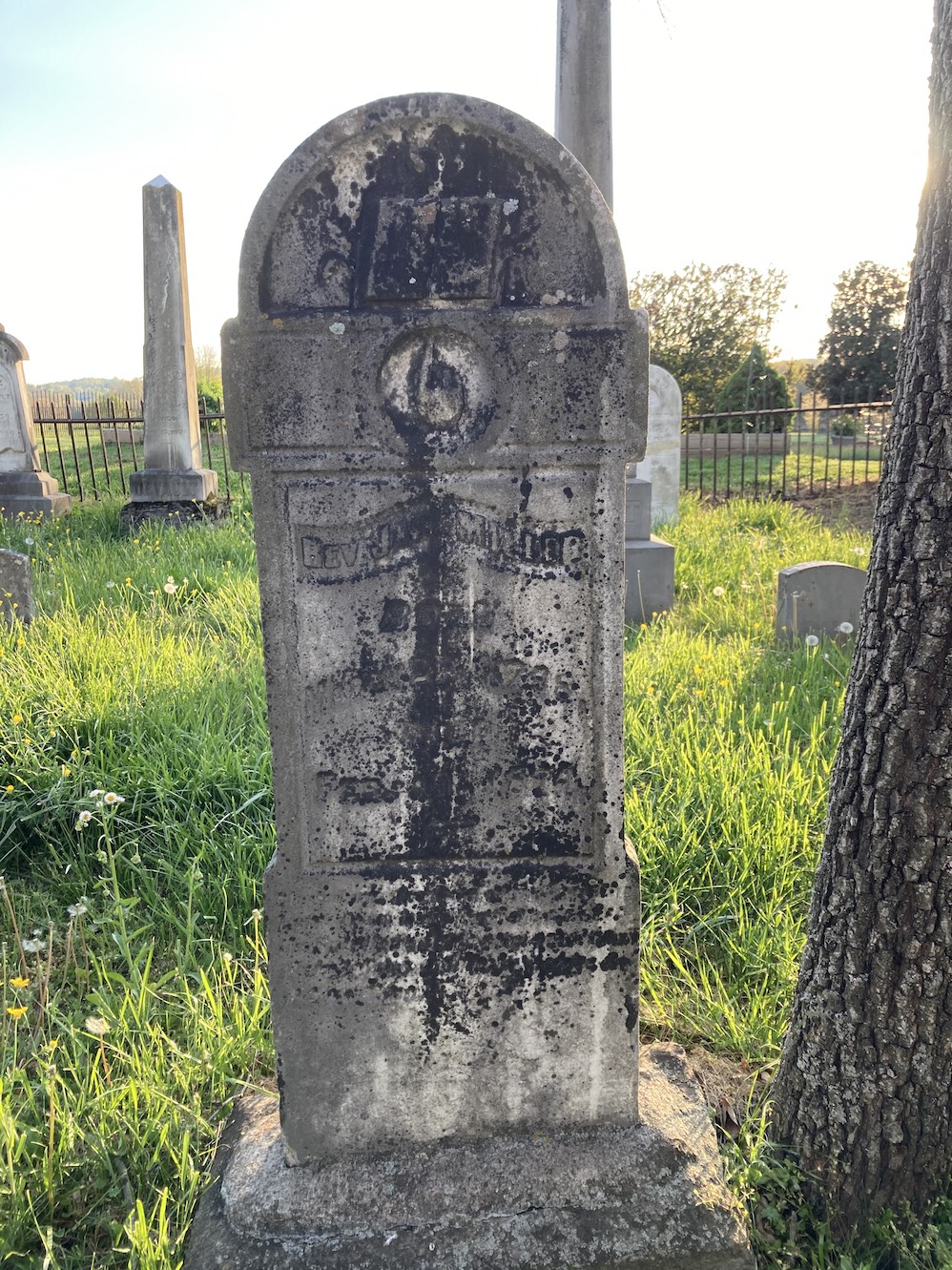
Rev. James Miller
Born
March 3, 1798
Died
February 19, 1874
(Writing Indiscernable)
![]()
Photos Taken 04.19.2021
Webpage produced 12.27.2022
Courtesy Of Scott Harp
www.TheRestorationMovement.com
Special Recognition: In September 2003 it was my privilege to spend the weekend in Knoxville, Tennessee with the South Knoxville church of Christ. I spoke that Sunday on the history of the Restoration Movement. I stayed in the home of Geoff and Angie Mabe. The Monday after, Geoff spent the day with me as we traveled east over to near Johnson City, Tennessee. We located and visited the graves of S. H. Millard and James Ireland Tipton. Included in the list of graves to locate was that of James Miller. Our time was short, and the location of the Devault Cemetery was not possible to find that day. Ever since, the grave location has been in my mind to find. It was wonderful to finally visit the grave of James Miller in April 2021 with my friends C. Wayne Kilpatrick and Tom L. Childers who traveled over with me to finally locate the grave of potentially East Tennessee's earliest preacher of gospel and planter of first century Christianity in that region.
![]()




